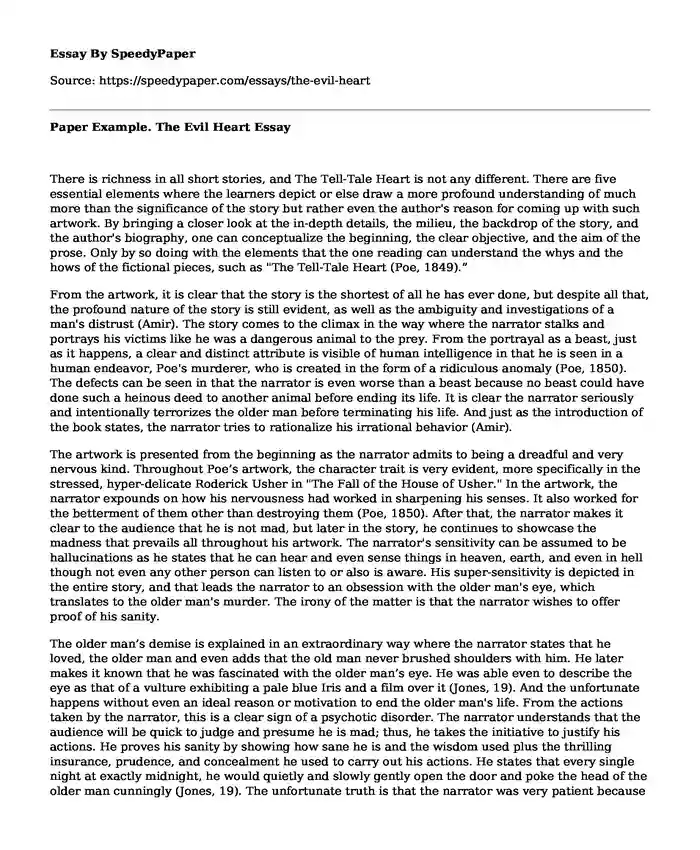
| Essay type: | Book review |
| Categories: | Analysis Edgar Allan Poe Books |
| Pages: | 3 |
| Wordcount: | 774 words |
There is richness in all short stories, and The Tell-Tale Heart is not any different. There are five essential elements where the learners depict or else draw a more profound understanding of much more than the significance of the story but rather even the author's reason for coming up with such artwork. By bringing a closer look at the in-depth details, the milieu, the backdrop of the story, and the author's biography, one can conceptualize the beginning, the clear objective, and the aim of the prose. Only by so doing with the elements that the one reading can understand the whys and the hows of the fictional pieces, such as "The Tell-Tale Heart (Poe, 1849).”
From the artwork, it is clear that the story is the shortest of all he has ever done, but despite all that, the profound nature of the story is still evident, as well as the ambiguity and investigations of a man's distrust (Amir). The story comes to the climax in the way where the narrator stalks and portrays his victims like he was a dangerous animal to the prey. From the portrayal as a beast, just as it happens, a clear and distinct attribute is visible of human intelligence in that he is seen in a human endeavor, Poe's murderer, who is created in the form of a ridiculous anomaly (Poe, 1850). The defects can be seen in that the narrator is even worse than a beast because no beast could have done such a heinous deed to another animal before ending its life. It is clear the narrator seriously and intentionally terrorizes the older man before terminating his life. And just as the introduction of the book states, the narrator tries to rationalize his irrational behavior (Amir).
The artwork is presented from the beginning as the narrator admits to being a dreadful and very nervous kind. Throughout Poe’s artwork, the character trait is very evident, more specifically in the stressed, hyper-delicate Roderick Usher in "The Fall of the House of Usher." In the artwork, the narrator expounds on how his nervousness had worked in sharpening his senses. It also worked for the betterment of them other than destroying them (Poe, 1850). After that, the narrator makes it clear to the audience that he is not mad, but later in the story, he continues to showcase the madness that prevails all throughout his artwork. The narrator's sensitivity can be assumed to be hallucinations as he states that he can hear and even sense things in heaven, earth, and even in hell though not even any other person can listen to or also is aware. His super-sensitivity is depicted in the entire story, and that leads the narrator to an obsession with the older man's eye, which translates to the older man's murder. The irony of the matter is that the narrator wishes to offer proof of his sanity.
The older man’s demise is explained in an extraordinary way where the narrator states that he loved, the older man and even adds that the old man never brushed shoulders with him. He later makes it known that he was fascinated with the older man’s eye. He was able even to describe the eye as that of a vulture exhibiting a pale blue Iris and a film over it (Jones, 19). And the unfortunate happens without even an ideal reason or motivation to end the older man's life. From the actions taken by the narrator, this is a clear sign of a psychotic disorder. The narrator understands that the audience will be quick to judge and presume he is mad; thus, he takes the initiative to justify his actions. He proves his sanity by showing how sane he is and the wisdom used plus the thrilling insurance, prudence, and concealment he used to carry out his actions. He states that every single night at exactly midnight, he would quietly and slowly gently open the door and poke the head of the older man cunningly (Jones, 19). The unfortunate truth is that the narrator was very patient because he would take an hour to execute the action of opening the door and poking the older man's head. He hopes the audience would be objective by stating that plus commenting on the horrible acts he undertook. He says that no madman would have been so wise to do such a thing.
Work Cited
Amir, Shamaila. "Analysis of the Short Story'The Tell-Tale Heart' by Edgar Allan Poe." The Creative Launcher 2 (2020).
Jones, Timothy. "Affairs of the Tell-Tale Heart." Journal of New Zealand Literature (JNZL) 35: 2 (2017): 15-31.
Poe, Edgar Allan. The Tell-Tale Heart. Strelbytskyy Multimedia Publishing, 2019.
Cite this page
Paper Example. The Evil Heart. (2023, Aug 13). Retrieved from https://speedypaper.com/essays/the-evil-heart
Request Removal
If you are the original author of this essay and no longer wish to have it published on the SpeedyPaper website, please click below to request its removal:
- The Lottery - A Literary Essay Example
- Free Essay Answering How "A Raisin in the Sun" Complicates the American Dream
- All's Well That Ends Well by Shakespeare on Character's Realism. Free Essay
- Free Essay Example. Ross Inc Financial Analysis
- Compare and Contrast Essay on Death of a Salesman and Tragedy of Hamlet
- Paper Example. Conceptual Guilt in the Book, Macbeth
- Unlocking the Power of Statistics in Healthcare: Analyzing Treatments, Risk, and Performance - Essay Sample
Popular categories




